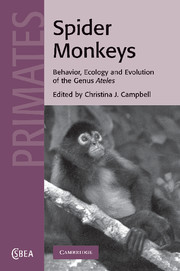Book contents
- Frontmatter
- Contents
- List of contributors
- Acknowledgements
- 1 Introduction
- Part I Taxonomy, phylogeny and evolution
- Part II Ecology
- Part III Behavior and reproduction
- 7 Locomotion and positional behavior of spider monkeys
- 8 Communication in spider monkeys: the function and mechanisms underlying the use of the whinny
- 9 Social interactions, social relationships and the social system of spider monkeys
- 10 Spider monkey reproduction and sexual behavior
- 11 Immaturity in spider monkeys: a risky business
- 12 Demography and group composition of Ateles
- Part IV Interactions with humans
- Index
- References
11 - Immaturity in spider monkeys: a risky business
Published online by Cambridge University Press: 05 May 2010
- Frontmatter
- Contents
- List of contributors
- Acknowledgements
- 1 Introduction
- Part I Taxonomy, phylogeny and evolution
- Part II Ecology
- Part III Behavior and reproduction
- 7 Locomotion and positional behavior of spider monkeys
- 8 Communication in spider monkeys: the function and mechanisms underlying the use of the whinny
- 9 Social interactions, social relationships and the social system of spider monkeys
- 10 Spider monkey reproduction and sexual behavior
- 11 Immaturity in spider monkeys: a risky business
- 12 Demography and group composition of Ateles
- Part IV Interactions with humans
- Index
- References
Summary
Introduction
Socialization is an important and complicated process in primates, involving morphological, ecological and social factors, which together serve to channel individuals into age- and gender-specific roles that help determine the population biology of each species. Despite its extreme importance, however, the socialization process has received little attention relative to primatological studies of adult nonhuman primates. Most studies have focused chiefly on social structure, as mediated by adults through dominance or affiliative interactions; mating strategies and their function in mediating the reproductive success of the mature individuals utilizing them; and socioecology, again primarily examining male and female adults' differential need for and utilization of resources and the resultant impact on social structure. This chapter investigates immature spider monkeys, that is, individuals from birth until emigration or attainment of social adulthood. The chapter focuses mainly on the Yucatecan spider monkey, Ateles geoffroyi, a relatively monomorphic and large-brained cebid with a complex social organization and social roles clearly differentiated by gender. Socialization and the immature phase in these spider monkeys will be considered in the broader context of the adult roles they will eventually exhibit and with regard to what is known about immaturity in primates in general.
Background
Much of the data available on immatures is based on infancy and parent–offspring relationships (usually mother–infant) (Gubernick and Klopfer, 1981; Taub, 1984), starting with and building on Harlow's pioneering work (Harlow, 1959; Harlow and Zimmermann, 1959; Harlow, 1971) on attachment and the role of maternal attributes in infant development.
- Type
- Chapter
- Information
- Spider MonkeysThe Biology, Behavior and Ecology of the Genus Ateles, pp. 288 - 328Publisher: Cambridge University PressPrint publication year: 2008
References
- 31
- Cited by

